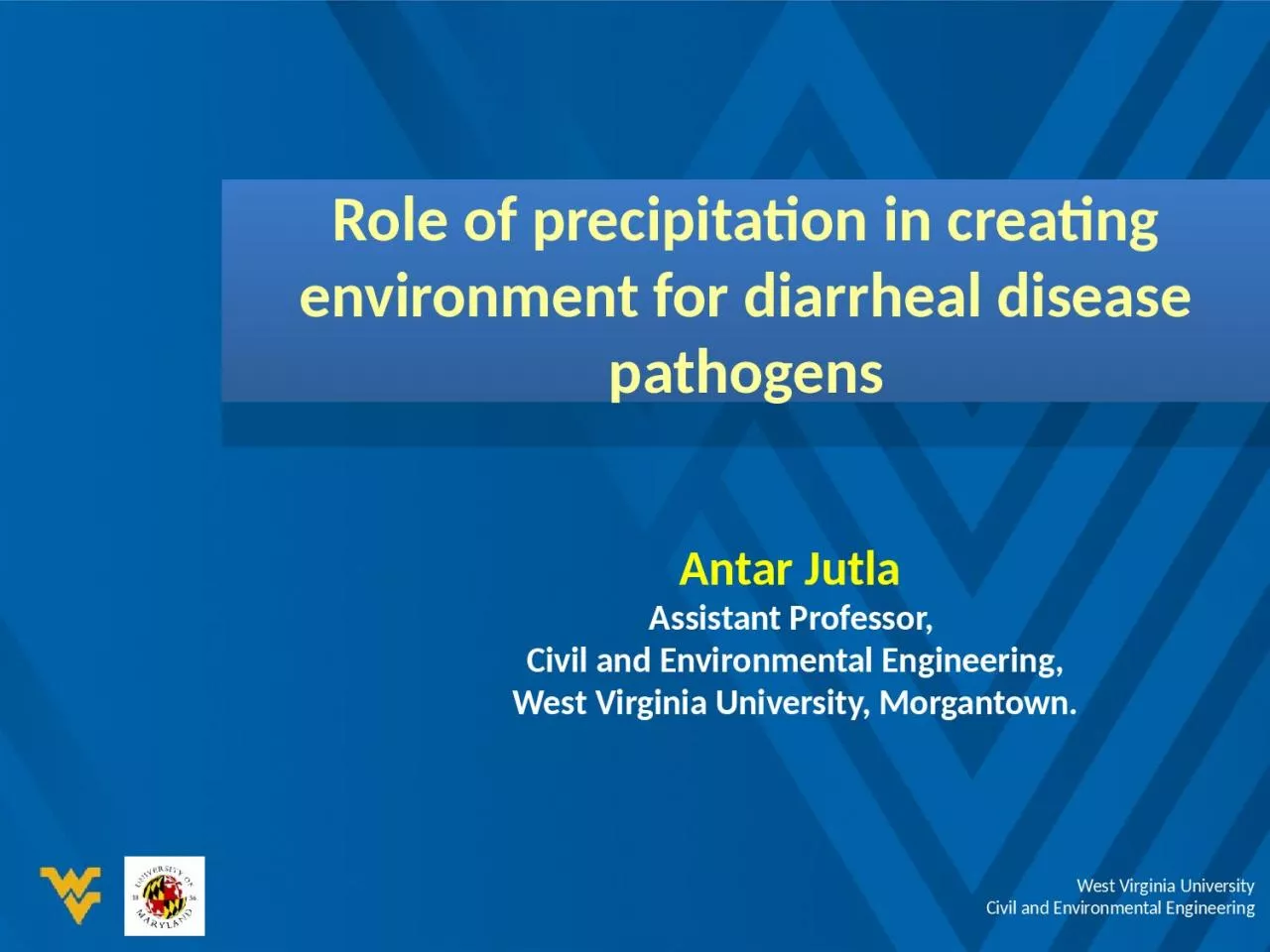

Antar Jutla Assistant Professor Civil and Environmental Engineering West Virginia University Morgantown MicroScale Environment processes within pathogens MacroScale Environment processes outside pathogens ID: 1037983
Download Presentation The PPT/PDF document "Role of precipitation in creating enviro..." is the property of its rightful owner. Permission is granted to download and print the materials on this web site for personal, non-commercial use only, and to display it on your personal computer provided you do not modify the materials and that you retain all copyright notices contained in the materials. By downloading content from our website, you accept the terms of this agreement.
1. Role of precipitation in creating environment for diarrheal disease pathogensAntar Jutla Assistant Professor, Civil and Environmental Engineering,West Virginia University, Morgantown.
2. Micro-Scale Environment(processes within pathogens)Macro-Scale Environment(processes outside pathogens)Ambient Environment(Population stress, Water security)Diarrheal DiseasesHow hydroclimate is related to Diarrhea?Jutla et al., 2010 (JAWRA)Our goal is to understand macro-environmental processes lead to disease outbreaks
3. Cholera ParadigmA perfect model for understanding diarrheal diseases
4. Cholera ModelJutla et al., 2015 (AJTMH-Accepted)
5. Predictive Epidemic Cholera Model
6. Predictive Epidemic Cholera Model
7. Predictive Epidemic Cholera Model
8. Predictive Epidemic Cholera Model
9. Predictive Epidemic Cholera Model
10.
11. Predictive Epidemic Cholera Trigger Model
12. Risks of cholera (diarrhea) in Nepal 2015?
13. Total Water Available in Basin(Surface and Ground water)GRACE satellite sensorsGanges Brahmaputra Regional River Discharge2-3 month lead time2-3 month lead time5-6 month lead timeDhakaCholera outbreaks Water scarcity driven choleraWater abundance driven choleraSeasonal bacteria intrusion due to low river dischargePredictive Endemic Cholera Model
14. Predictive Endemic Cholera Model
15. Predictive Endemic Cholera Model
16. Predictive Endemic Cholera Model
17. Future Work Field validation trials for microbiological water quality at multiple locations Uncertainty in predictions, creating global database on diseaseOther diarrheal pathogens (Norovirus, Shigella, Vibrio parahaemolyticus, Vibrio vulnificus)Understand and synthesize scale issues for linking land surface models with disease transmission algorithms
18. Where we need help?Student webinars on available products-perhaps listserve type announcements. Reduce latency time of IMERG data (or, availability of algorithms?) Comparison of TRMM (3B43)and IMERG data, or atleast provide both dataset on same grid (or algorithms)Uncertainty in IMERG data (especially on daily scales)Restructuring data access for FTPE.g., for obtaining IMERG on monthly scales, the file is located in day 1 folder of each month?
19. Collaborators Rita Colwell, University of Maryland Shafqat Akanda, University of Rhode IslandHelen Nyugen, University of Illinois-UrbanaBrad Sack, Johns Hopkins UniversityJuliet Iwelunmor, University of Illinois-UrbanaMunir Alam, ICDDRBMauro Colombo, UEM, MozambiqueEnvironment and Public Health Organization (ENPHO), NepalSaiful Islam, BUET, BangladeshThis research is supported, in part, from a grant by NASA-Health and Air Quality Applications (NNX15AF71G)
20. Thank you
21.
22. Jutla, A.S., Huq, A. and Colwell, R. 2015. Diagnostic approach for monitoring hydroclimatic conditions related to emergence of West Nile Virus in West Virginia. Frontiers Journal of Public Health. doi: 10.3389/fpubh.2015.00010. Nasr-Azadani, F., Unnikrishnan, A., Akanda, A., Islam, S., Alam, M., Huq, A., Jutla, A., and Colwell, R. 2015. A framework for downscaling river discharge to assess the effects of climate change on endemic cholera. Climate Research. doi: 10.3354/cr01310Akanda, A.S., Jutla, A.S. and Colwell, R. 2014. Global diarrhoea action plan needs integrated climate-based surveillance, The Lancet-Global Health, 2(2):69-70.Luo, T., Jutla, A.S., and Islam, S. 2015. Evapotranspiration Estimation over Agricultural Plains using MODIS Data for All Sky Conditions, International Journal of Remote Sensing, doi: 10.1080/01431161.2015.1009648 Jutla, A.S., Whitcombe, E, Hasan, H., Haley, B., Akanda, A., Huq, A., Alam, M., Sack, B., Colwell, R. 2013. In Response: Environmental Factors Influencing Epidemic Cholera. American Journal of Tropical Medicine and Hygiene 89(6): 1231–1232. Jutla, A.S., Whitcombe, E, Hasan, H., Haley, B., Akanda, A., Huq, A., Alam, M., Sack, B., Colwell, R. 2013. Environmental factors influencing epidemic cholera. American Journal of Tropical Medicine and Hygiene, 89(3):597-607.Jutla, A.S., Akanda, A.S. and Islam, S. 2013 A framework for predicting endemic cholera using satellite derived environmental determinants. Environmental Modelling and Software, 47:148-158.Jutla, A.S., Akanda, A.S., Huq, A., Faruque, A., Colwell, R. and Islam, S. 2013 A water marker monitored by satellites to predict endemic cholera, Remote Sensing Letters, 4(8):822-831.Akanda, A.S., Jutla, A.S., Gute, D., Sack, R., Alam, M., Huq, A., Colwell, R., and Islam, S. 2013. Population vulnerability to biannual cholera outbreaks and associated macro-Scale drivers in Bengal Delta, American Journal of Tropical Medicine and Hygiene, 89(5):950-959.. Jutla, A.S., Akanda, A.S. and Islam, S. 2011. Satellite space-time variability of chlorophyll in Bay of Bengal: Connections to cholera outbreaks. Remote Sensing of Environment. 123:196-206Akanda, A.S., Jutla, A.S., Gute, D.M., Evans, T. and Islam, S. 2011. Reinforcing cholera intervention through prediction aided prevention. Bulletin of the World Health Organization, 90(3):243-244.Jutla, A.S., Akanda, A.S, Griffiths, J. Islam, S. and Colwell, R. 2011. Warming oceans, phytoplankton, and river discharge:Implications for cholera outbreaks. American Journal of Tropical Medicine and Hygiene. Doi:10.4269/ajtmh.2011.11-0181Akanda, A.S., Jutla, A.S., Siddique, A.K., Alam, M., Sack, R., Huq, A., Colwell, R. and Islam, S. 2011. Hydroclimatic influences on seasonal and spatial cholera transmission cycles: Implications for public health intervention in the Bengal Delta, Water Resources Research, 47, W00H07, doi:10.1029/2010WR009914Jutla, A.S., Akanda, A.S. and Islam, S. 2010. Tracking cholera in coastal regions using satellite observations. Journal of American Water Resources Association. 46(4):651-662. Doi: 10.1111/j.1752-1688.2010.00448.x.Akanda, A. S., Jutla, A.S. and Islam, S. 2009. Dual peak cholera transmission in Bengal Delta: A hydroclimatological explanation, Geophysical Research Letters, 36, L19401, doi:10.1029/2009GL039312. Publications
23. Predictive Epidemic Cholera Transmission Model
24. Four week differencePredictive Epidemic Cholera Transmission Model
25. Epidemic cholera New and unexpected regions, particularly in Asia and Africa, are likely to experience this form of diarrheal diseases
26. Epidemic Cholera under Changing Climate
27.